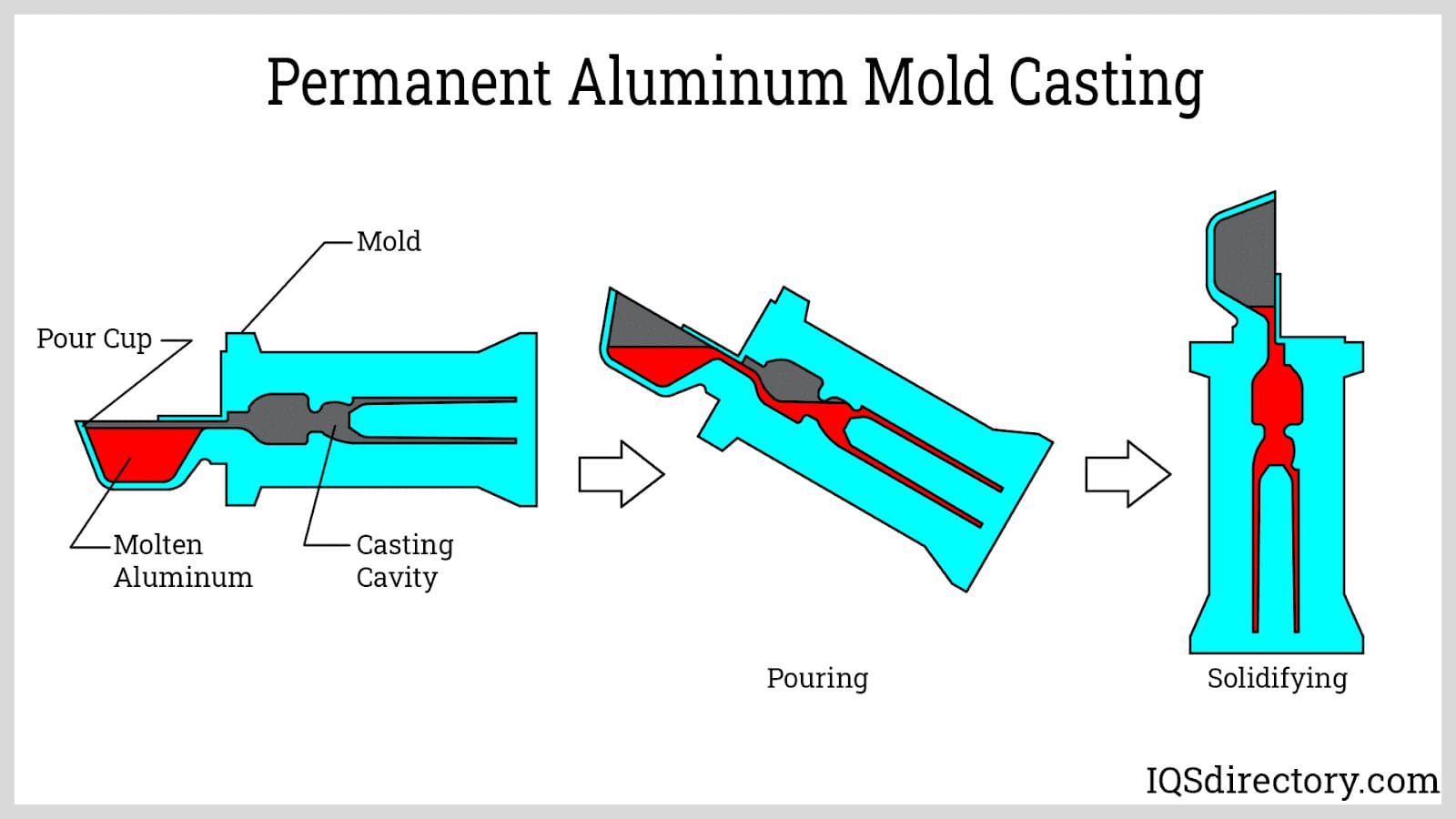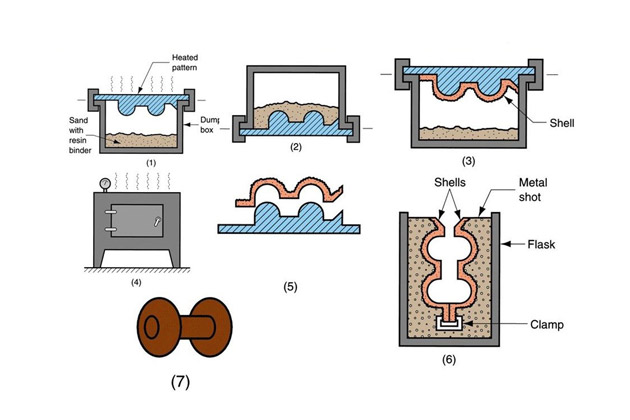How to Evaluate Quality Standards in an Aluminum Casting Manufacturer
Wiki Article
Understanding the Manufacturing Process of Light Weight Aluminum Casting: A Comprehensive Overview
The manufacturing process of aluminum Casting is elaborate and multifaceted. It encompasses different strategies that transform liquified aluminum into exact shapes. Each technique, from sand Casting to die casting, plays a vital function in the end product's top quality. Understanding the subtleties of aluminum alloys and melting processes is fundamental. As one discovers the details of molding and ending up strategies, the importance of quality assurance comes to be noticeable. What variables absolutely affect the success of this process?The Fundamentals of Aluminum Casting
Aluminum Casting is an essential manufacturing process that changes molten light weight aluminum right into precise, detailed shapes. This process starts with the careful melting of aluminum ingots or scrap in a heating system, where temperatures go beyond 660 levels Celsius. As soon as molten, the aluminum is put into pre-designed mold and mildews, which determine the final kind of the cast element.Air conditioning happens as the light weight aluminum strengthens, enabling it to tackle the features of the mold and mildew. The top quality of the end product is influenced by variables such as the pureness of the light weight aluminum, the design of the mold and mildew, and the air conditioning rate. After solidification, the molds are removed to disclose the actors piece, which might undergo additional completing procedures, such as machining or surface area therapy, to satisfy specific resistances and aesthetic demands. Generally, light weight aluminum Casting acts as a fundamental strategy in the production of numerous components throughout markets.
Sorts Of Aluminum Casting Processes
The different aluminum Casting procedures play an essential function in producing effectiveness and item top quality. Secret approaches consist of sand casting, which is cost-effective and flexible; pass away casting, known for its precision and speed; and permanent mold and mildew casting, which offers resilience and enhanced surface coating. Each technique has its distinct advantages, making them appropriate for different applications in the industry.Sand Casting Strategy
While many Casting methods exist, sand Casting remains one of one of the most extensively used methods for shaping light weight aluminum parts. This process involves creating a mold from sand, which is compressed around a pattern to create the preferred shape. As soon as the mold and mildew is prepared, molten aluminum is poured into the tooth cavity, where it takes and solidifies on the type of the mold and mildew. Sand Casting is particularly valued for its versatility, allowing for the manufacturing of complicated forms and sizes. Furthermore, it is economical for both small and huge production runs. The technique appropriates for various light weight aluminum alloys, making it a prominent option in sectors ranging from vehicle to aerospace. Its simpleness and adaptability contribute to its long-lasting popularity in light weight aluminum casting.Die Casting Technique
Die Casting stands for a highly effective method for producing light weight aluminum elements, identified by its capacity to produce intricate forms with exceptional dimensional accuracy. This process includes requiring molten light weight aluminum right into a steel mold at high pressure, which enables for fast production and very little waste. There are 2 main kinds of die casting: hot chamber and chilly chamber. Warm chamber die Casting is suitable for low-melting-point alloys, while cold chamber die Casting is ideal for higher melting points, offering adaptability in product choice. The die Casting method not only ensures smooth surface area finishes but likewise allows the production of complex geometries that are challenging to achieve with various other Casting methods. Overall, pass away Casting is crucial for markets requiring high-volume manufacturing of precision parts.Long-term Mold And Mildew Casting

The Aluminum Casting Materials
Light weight aluminum casting relies upon a range of materials to attain the preferred homes and efficiency features of the final product. The key material used is aluminum alloy, which consists of numerous components such as silicon, zinc, magnesium, and copper to improve details attributes like strength, deterioration resistance, and thermal conductivity. The choice of alloy is essential, as it straight affects the mechanical residential properties and casting behavior.In enhancement to the aluminum itself, other materials play considerable duties in the Casting process. Sand, utilized in sand casting, offers the mold structure, while ceramic materials can be made use of for intricate forms in financial investment spreading. Furthermore, additives like fluxes may be included to enhance fluidity and minimize oxidation throughout the Casting procedure. Each of these products is selected based upon the needs of the end product, making certain optimal performance and toughness in its desired application.
The Light Weight Aluminum Melting Refine
Before spreading, the light weight aluminum has to go through a melting procedure to change it from solid to fluid form. This procedure commonly happens in a furnace, where the light weight aluminum is heated up to its melting point, around 660 levels Celsius (1220 levels Fahrenheit) Various kinds of heaters might be employed, consisting of induction, resistance, and gas-fired heaters, each supplying various benefits concerning effectiveness and environmental impact.
Molding Methods in Aluminum Spreading
Molding techniques play a crucial role in the light weight aluminum Casting process, affecting both the quality and efficiency of the final item. The sand molding procedure and different die Casting approaches are 2 primary strategies utilized in the market. Each approach uses distinctive advantages and is matched for various applications, influencing the overall manufacturing end result.Sand Molding Refine
While various methods exist for forming aluminum spreadings, the sand molding procedure continues to be one of one of the most commonly made use of techniques in the market. This technique utilizes a mix of sand, clay, and water to produce molds that can stand up to the high temperatures of liquified aluminum. The procedure starts with developing a pattern, generally made from metal or plastic, which is after that pushed right into the sand combination to form the mold cavity. As soon as the pattern is removed, the mold is assembled, and molten aluminum is poured right into the cavity. After cooling down, the sand is damaged away, revealing the completed spreading. Sand molding uses adaptability in style and is affordable, making it ideal for both little and big manufacturing runs.Die Casting Methods
Die casting techniques stand for one more substantial method in light weight aluminum casting, offering distinct benefits over typical sand molding. This procedure includes forcing molten aluminum right into a steel mold under high pressure, making it possible for the production of intricate forms with tight resistances. There are two main types of die spreading: warm chamber and cool chamber. In hot chamber die casting, the shot system is immersed in liquified steel, suitable for low-melting-point alloys. Conversely, chilly chamber die Casting calls for the steel to be thawed in a separate heater and afterwards infused right into the mold and mildew, making it ideal for higher melting-point alloys. Both techniques enhance manufacturing efficiency, lower waste, and enhance surface area finishes, making die casting a recommended option for many applications in the manufacturing industry.Completing Processes for Aluminum Castings
Ending up procedures are necessary to enhance the appearance and efficiency of light weight aluminum spreadings, guaranteeing they meet the details needs of different applications. These procedures include cleaning, surface therapy, and layer. Cleaning up gets rid of any kind of recurring products, such as oils or sand, from the Casting surface, preparing it for more treatment.Surface area therapy approaches, such as shot sanding or blowing up, aid attain an uniform appearance and boost bond for finishes - Aluminum Casting Manufacturer. Anodizing is a popular covering method that boosts corrosion resistance and provides a cosmetically pleasing coating
In addition, powder coating can use long lasting color alternatives, while paint permits for modification in look. Machining might also be employed to attain specific dimensions or extra surface coatings. Each completing procedure plays an important role in improving both the visual and functional facets of aluminum spreadings, contributing to their overall high quality and longevity in numerous commercial applications.
Quality Assurance in Light Weight Aluminum Casting
Quality assurance in aluminum Casting is an important facet of the manufacturing process that guarantees the last items satisfy the required standards and requirements. This process involves systematic examinations and examinations throughout various phases of manufacturing. Initially, raw materials are examined for chemical structure and contaminations to verify they adapt market norms. During casting, parameters such as air conditioning, temperature level, and stress rates are carefully kept track of to avoid issues like porosity or misalignment.Post-casting inspections consist of non-destructive screening methods, such as X-ray or ultrasonic exams, to spot internal flaws. Furthermore, dimensional checks examine the precision of the actors parts versus layout requirements. The implementation of quality management systems assists in recording and tracking these processes, enabling for constant enhancement. Aluminum Casting Manufacturer. By sticking to rigorous quality assurance measures, makers can boost product integrity and efficiency, ultimately satisfying consumer requirements and reducing manufacturing costs related to rework or scrap
Regularly Asked Questions
What Are the Ecological Influences of Light Weight Aluminum Spreading?
The ecological influences of light weight aluminum Casting include energy intake, greenhouse gas emissions, and waste generation. In addition, the procedure can lead to water pollution and environment devastation, highlighting the need for lasting techniques in the sector.Exactly How Does Light Weight Aluminum Casting Compare to Various Other Metal Casting Processes?
Aluminum casting deals benefits such as lower melting temperatures and lighter weights compared to various other metal Casting procedures. This results in minimized energy intake and higher style adaptability, making it a recommended option for numerous applications.What Safety Measures Are Needed Throughout Light Weight Aluminum Spreading?
Precaution during aluminum Aluminum Casting Manufacturer Casting include putting on safety gear, guaranteeing correct ventilation, maintaining tools on a regular basis, executing fire safety and security protocols, and offering training on taking care of liquified steel to minimize mishaps and health and wellness dangers in the office.Exactly How Can I Recycle Light Weight Aluminum Castings Properly?
Recycling light weight aluminum spreadings successfully entails accumulating scrap, cleansing contaminants, and melting the light weight aluminum (Aluminum Casting Manufacturer). The procedure ought to guarantee appropriate splitting up of various alloys to keep top quality, followed by casting into new kinds for reuse in productionWhat Prevail Defects in Aluminum Castings and Their Reasons?
Typical problems in light weight aluminum castings include shrinking, porosity, and imbalance. These problems often occur from poor melting temperatures, incorrect mold and mildew layout, or inadequate cooling rates, impacting the final item's stamina and integrity.Each method, from sand Casting to die casting, plays a vital duty in the last item's high quality. Key approaches include sand casting, which is functional and cost-efficient; die casting, understood for its precision and rate; and irreversible mold and mildew casting, which uses longevity and enhanced surface coating. While lots of Casting methods exist, sand Casting continues to be one of the most extensively utilized strategies for forming light weight aluminum parts. The die Casting technique not only assures smooth surface coatings yet additionally enables the production of complex geometries that are difficult to achieve with various other Casting methods. Sand, utilized in sand casting, provides the mold structure, while ceramic products can be utilized for complex forms in financial investment spreading.
Report this wiki page